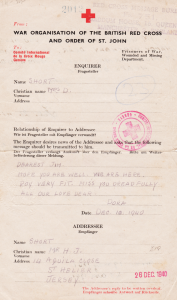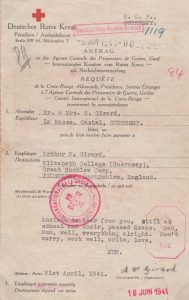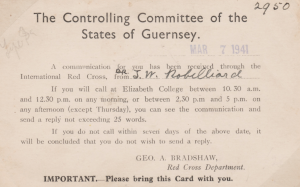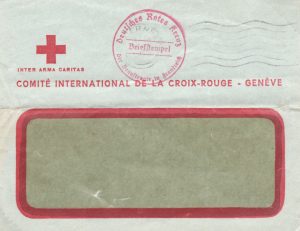Islanders could send messages to their relatives in England or other unoccupied countries via the International Red Cross. These messages were typed on special forms provided by the German Red Cross. These were sent via the local Red Cross Message bureau. Similarly, the Islanders were able to receive messages from England on forms provided by the British Red Cross. There was space on the back of the form for the Islanders to reply. These can make their study a fascinating subject for collection. This Red Cross message was sent from Manchester to Jersey in December 1940. Messages could have a maximum of 25 words. This was forwarded from London to neutral Lisbon, then to Geneva where this form received the red double circle Red Cross handstamp. The route to Jersey was then via Paris. This form was 6 weeks in transit.
This message form is a German type sent from Guernsey. This is a children’s message. Children on Guernsey were evacuated to England prior to the Occupation. This message was sent from Arthur’s parents in Guernsey to their son who was at Elizabeth College, then situated in Derbyshire. This was censored on arrival in England. The octagonal censor handstamp (P173) can be seen on the form. On receipt, he wrote a reply on the reverse of this form which was then returned to his parents.
Initially, when a message form or reply arrived in Guernsey, the local Red Cross Message Bureau (situated in Elizabeth College) would send a card to the addressee informing them that a message had arrived in the Island. They should visit the Bureau in order to send a reply. These cards are known as ‘Bradshaw Cards’. There are many different types and they are very collectable. This Bradshaw card scheme finished in May 1942. From then onwards forms were posted to the recipients in Red Cross envelopes.
For more information please see ′The Red Cross Civilian Postal Message Scheme with the Channel Islands, 1940-45′ by D. Gurney.




